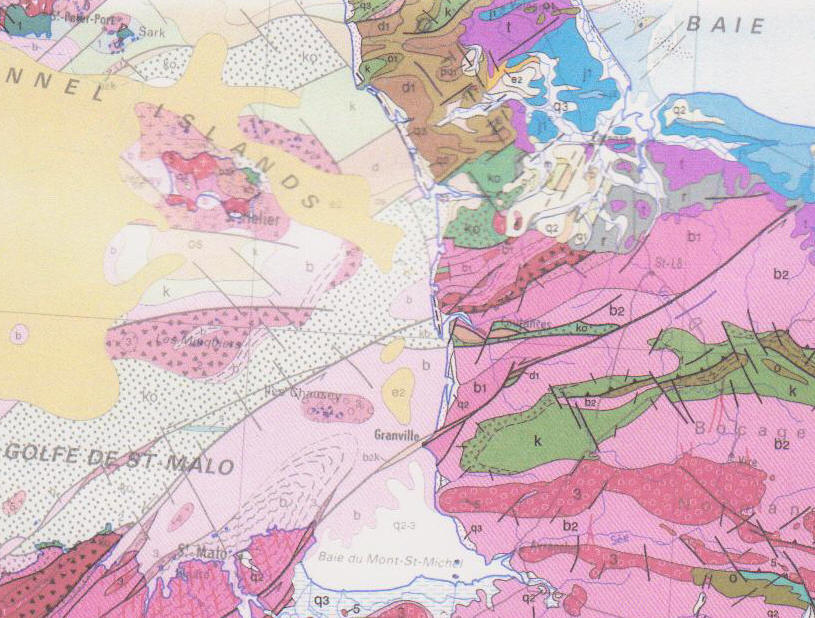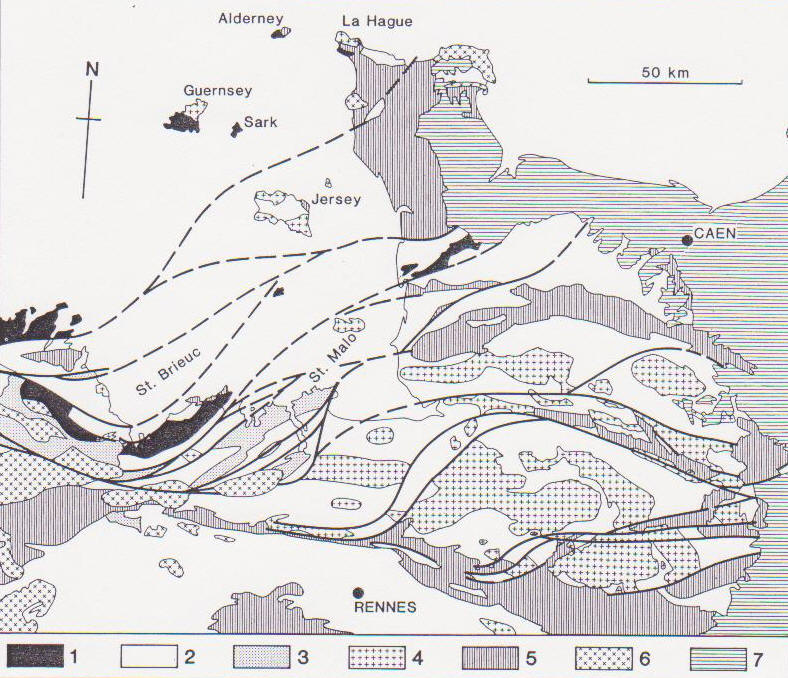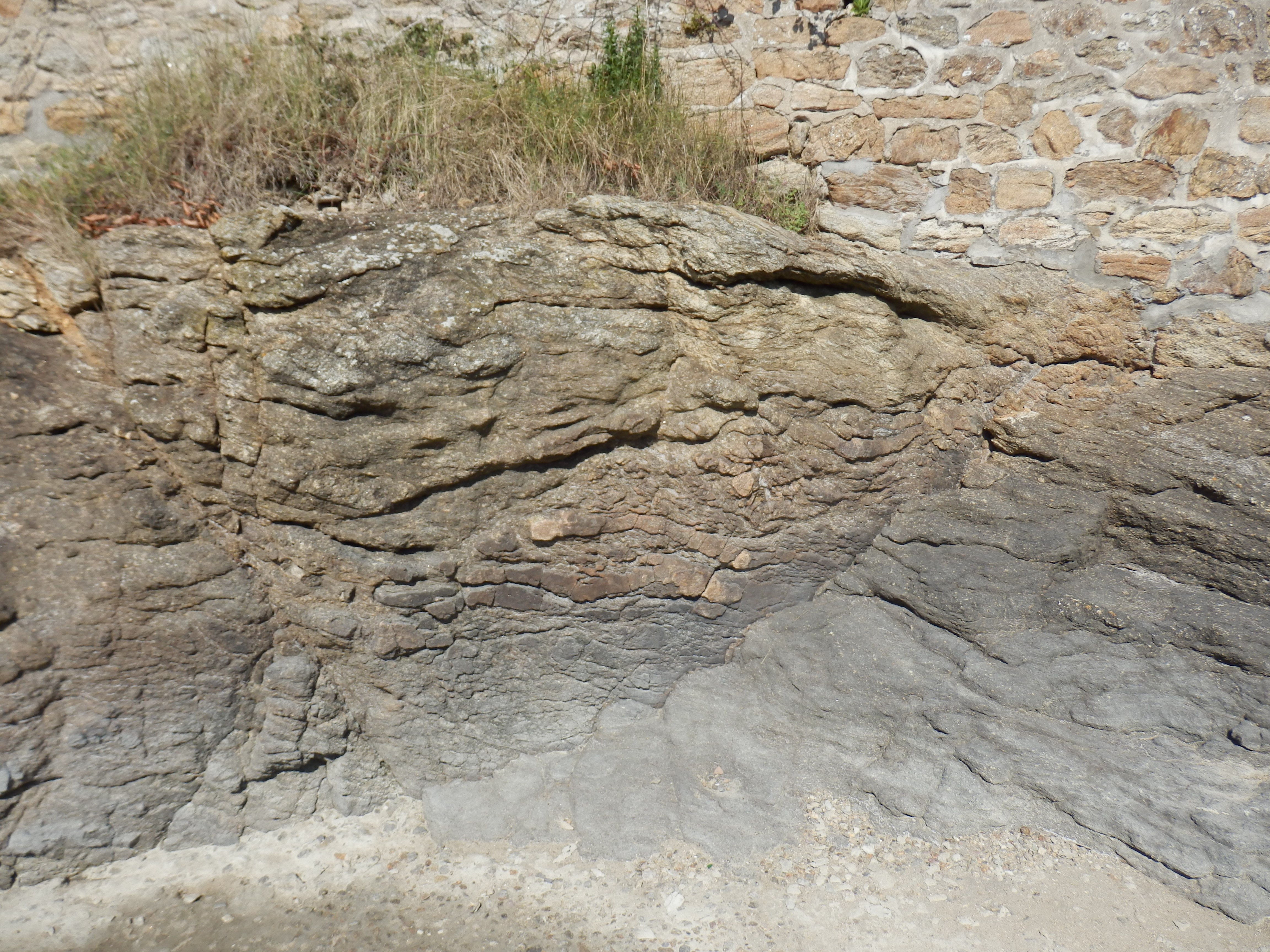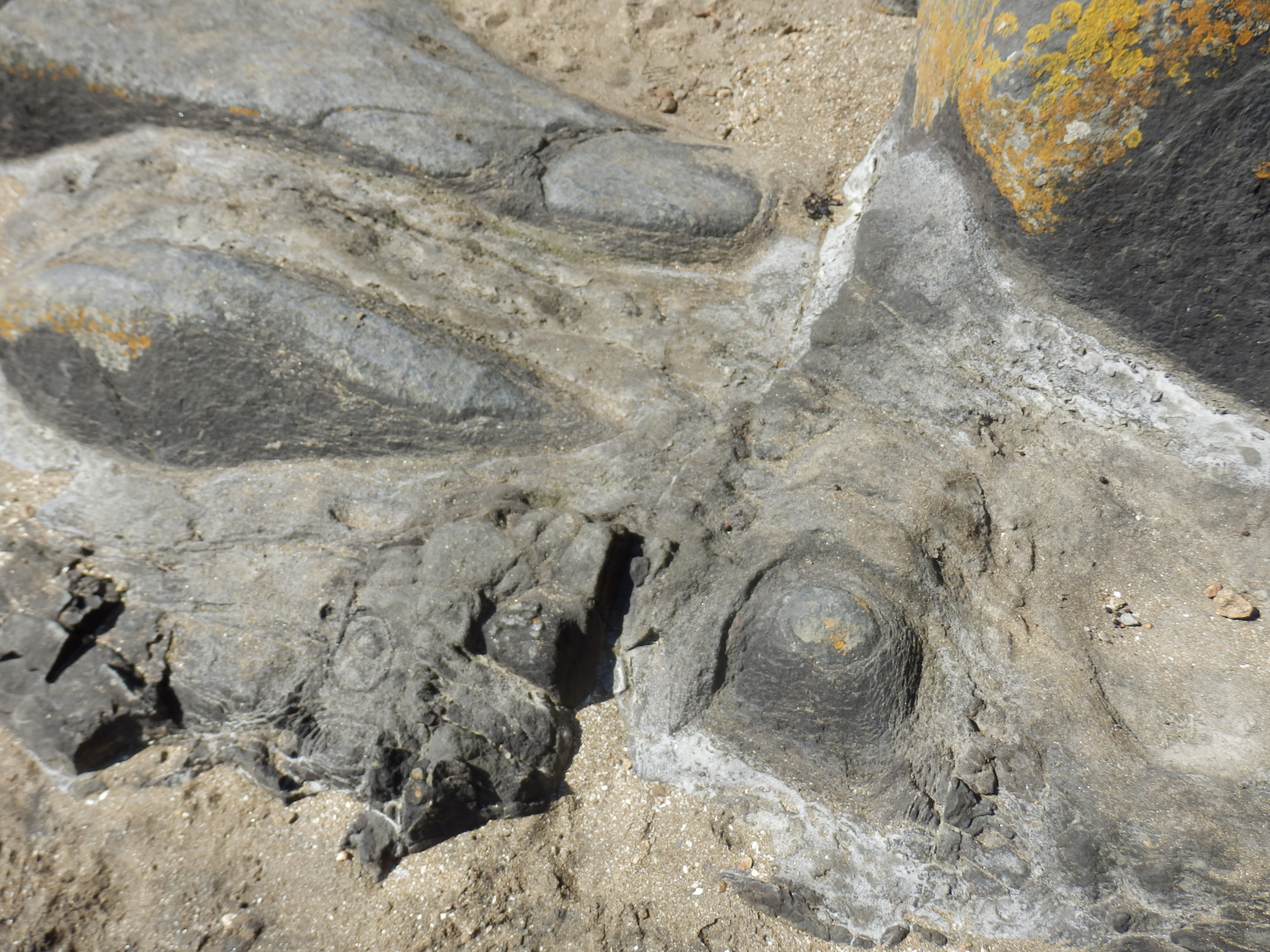Jersey Geology Trail |
|
The Brittany Connection. |
|
 |
|
Geological setting of NE Brittany, Jersey, its reefs and western Cotentin Normandy); Brioverian shales (pink), igneous and metamorphic rocks (reds); Palaeozoics (green & brown); Eocene limestone (yellow). La Carte Géologique de France, 2003. |
|
Fifty years ago, the east-west trending Palaeozoic structures of south western England, South Wales and Southern Ireland were shown on geological maps of north western Europe as part of the Hercynian (with Armorican and Variscan zones) fold belt of Devonian and Carboniferous rocks; these maps included southern Normandy, Brittany and the Channel Islands complete with granite masses. Although these areas have been subjected to Hercynian* folding, the work of British and French authors had shown that this region belongs to the Armorican Massif consisting of Precambrian sedimentary, metamorphic and igneous rocks (plutonic and volcanic) and Lower Palaeozoic sedimentary and igneous (plutonic, minor intrusive and volcanic rocks) all affected by phases of the Cadomian Orogeny (named after Cadomus, the Roman name for Caen)which occurred between c. 700 Ma and c. 400 Ma ago (Brown et al. 1990, p. 186). {* Hercynian or Variscan orogeny (named from the Harz and the Fichtelgebirge in Bavarian areas of Germany) lasting from the Devonian through the Carboniferous and terminating with the Permian, producing the Hercynian mountain chain which affected what is now SW England, NW Europe, southern Europe and the Pyrenees and the Appalachian parts of the eastern USA (Allaby & Allaby, 1999, p.258; Foucault & Raoult, 2000, pp. 170 & 366)}. |
|
Jersey is situated in Northern Armorica, north of the nearest part of Brittany, which is divided from Central Armorica by the North Armorican Shear Zone. Northern Armorica consists of several terranes - the St. Brieuc, St. Malo and Mancellian Terranes which form the North Armorican Composite Terrane with Jersey situated in the northern part of the St. Brieuc Terrane (Brown et al.1990, p.183 - 184). |
|
 |
|
1. Early Cadomian foliated plutonic complexes. |
|
Generalised geological map of the NE Armorican Massif (Brown et al. loc cit. p.183). |
|
These terranes are separated from each other by curved strike-slip, possibly transpressional shear zones which are shown to be splay faults from the North Armorican Shear Zone mentioned above, and which strike ENE extending into Normandy (Brown et al. 1990, pp. 181 - 4). Jersey is shown between to such inferred strike-slip faults, the northern one separating us from Guernsey, Sark, Alderney and the Cap de la Hague area of north west Cotentin (Normandy). The ages of the various rock masses of the terranes are also summarised (loc. cit. p.185) The St. Brieuc Terrane consisting of several structural blocks, comprises foliated plutonic complexes with remnants of the older Icartian Gneiss (2000 Ma old) in Guernsey, Brioverian (Upper Precambrian) volcanic and sedimentary rocks, and Lower Palaeozoic sedimentary rocks in synclines which generally strike north easterly parallel with the shear zones, for example in NE Jersey, the NW Cotentin in Normandy and the areas we visited in the central and southern Cotentin. There are also small post-tectonic igneous complexes such as those in Jersey. The St. Malo Terrane consists of the Brioverian volcanic and metasedimentary rocks of the St. Brieuc area which can also be seen in quarries south of Dinan but also of high grade gneisses and migmatites (possibly altered Brioverian rocks) seen around the coast in St. Malo. Post-tectonic granite/granodiorite complexes also occur, for example Chausey, in the quarry at Lanhélin, south west of Pontorson, and in the Vire and Mancellian areas which exhibit different facies and were intruded at different times between c. 590 - 500 Ma. Detailed descriptions of the various granites are given in the itineraries in Le Guide Géologique de la Bretagne (Lardeux et al. 1996, p. 29 et seq). The migmatites of the St Malo Terrain (left photograph below) were later intruded by N - S striking dolerite dykes which may be coeval with the later N - S striking dykes in Jersey. When weathered by 'onion (spheroidal) weathering' (Graviou, P. 2012, p. 56 - 57) and then eroded, large boulders remain, some of which ring when struck, for example at St. Guildo where they are called the Les Pierres Sonnantes (the Ringing Stones). Examples of boulders in process of formation, surrounded by foliated outer layers can still be seen (right photograph below). Similar spheroidal weathering occurs in Jersey (see granodiorites and andesites). |
|
 |
 |
The Mancellian Terrane, further east and into Normandy, consists of the Brioverian rocks and Lower Palaeozoic post-tectonic (late Cadomian) plutonic complexes. It is notable that there are Variscan plutonic masses in the southern parts of the St. Brieuc and St. Malo Terranes predating and post dating the shear zones. There also seems to be a dextral element nearer the North Armorican Shear Zone in the pre-shear masses (loc.cit. p.183). The beautiful pink and red granites of Ploumanac'h further west are also of Hercynian age (end of the Carboniferous, c. 290 Ma) Jersey is composed of some of the Brioverian sedimentary rocks (The Jersey Shale Formation), the volcanic rocks (The Jersey Volcanic Group), the Lower Palaeozoic sedimentary rocks (The Rozel Conglomerate Formation) and the post-tectonic plutonic complexes (The Southeast, Southwest and Northwest Igneous Complexes). Jersey is described as being at a higher structural level and Brown et al. (1990, p.186), quoting the work of Strachan & Roach (1990, pp.133 - 134) concerning the five structural blocks of the St. Brieuc Terrane, state that we probably represent part of a sixth structural block. We are shown to be separated from Brittany by several curved, inferred strike-slip shear zones (transpressional faults), striking ENE - WSW across the Bay of St. Malo into Normandy, and it is thought that the amalgamation of the above terranes into the Composite Terrane occurred during the Cadomian Orogeny, the whole cycle lasting 300 Ma from c. 700 Ma to c. 400 Ma (loc. cit. p. 186). Our granites are described as late Cadomian post-tectonic (the folding of the Jersey Shale Formation) plutonic complexes which, along with the andesite and rhyolite volcanism represents the late stage of the Cadomian with the decay of the subduction zone to the north west. In summary, the early Cadomian foliated plutonic complexes are equated with volcanic arc granites in a subduction zone environment; the post tectonic (late Cadomian) plutonic complexes equate with mature continental arc activity in late subduction activity after the strike-slip terrane accretion; and the St. Malo Terrane represents an inverted intra- or behind-arc basin. This structural setting is compared with the development of the Andes in northern Chile which exhibited similar subduction and arc basin environments during the westward movement of S. America. Cadomia (or Armorica) was situated on the northern edge of a super continent, part of Gondwana, and moved north between Cambrian and early Devonian times across the South Pole (remember the Tillites of Feugerolles, near May-sur-Orne) with associated intrusion of granite complexes of various ages and finally by the dyke swarm in Ordovician to Silurian times (Brown et al. 1990, pp. 207 - 208). The region further south of the shear zone, the Central Armorican Terrane however, is a different story. There's an angular unconformity separating Brioverian and Palaeozoic rocks and it wasn't notably deformed until Variscan times but both terranes had subsequent variable Variscan modification (loc. cit. p. 186) |
|
References. Allaby, A. and Allaby, M. 1990. A Dictionary of Earth Sciences. 2nd. Ed. Oxford University Press. Brown, M. Power, G. M. Topley, C. G. & R. S. D'Lemos, R. S. 1990. Cadomian magmatism in the North Armorican Massif. p. 181 - 213, in The Cadomian Orogeny. Eds. D'Lemos, R. S., Strachan, R. A. & Topley, C. G., 1990, Geological Society Special Publication No. 51. D'Lemos. R. S., Strachan. R. A. and Topley. C. G. Eds. 1990. The Cadomian Orogeny. Geol. Soc. Spec. Publ. No. 51. The Geological Society. Foucault, A. & Raoult, J-F. 2000. Dictionnaire de géologie. Dunod. Lardeux, H. (Coordonnateur) et al, 1996. Guide Géologique de la Bretagne. Masson. Strachan, R. A., & Roach, R. A. 1990. Tectonic evolution of the Cadomian belt in Northern Brittany. In D'Lemos et al. (Eds.) The Cadomian Orogeny. Geological Society. London. Special Publication, No. 51. pp. 133 - 150. |
|